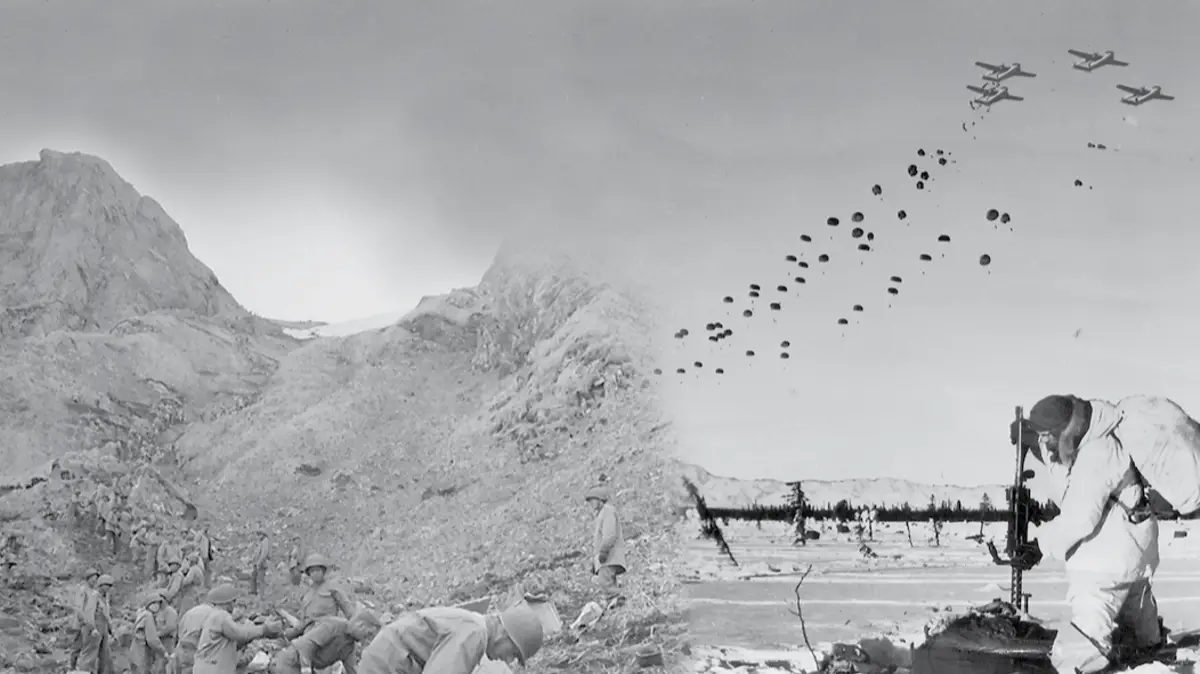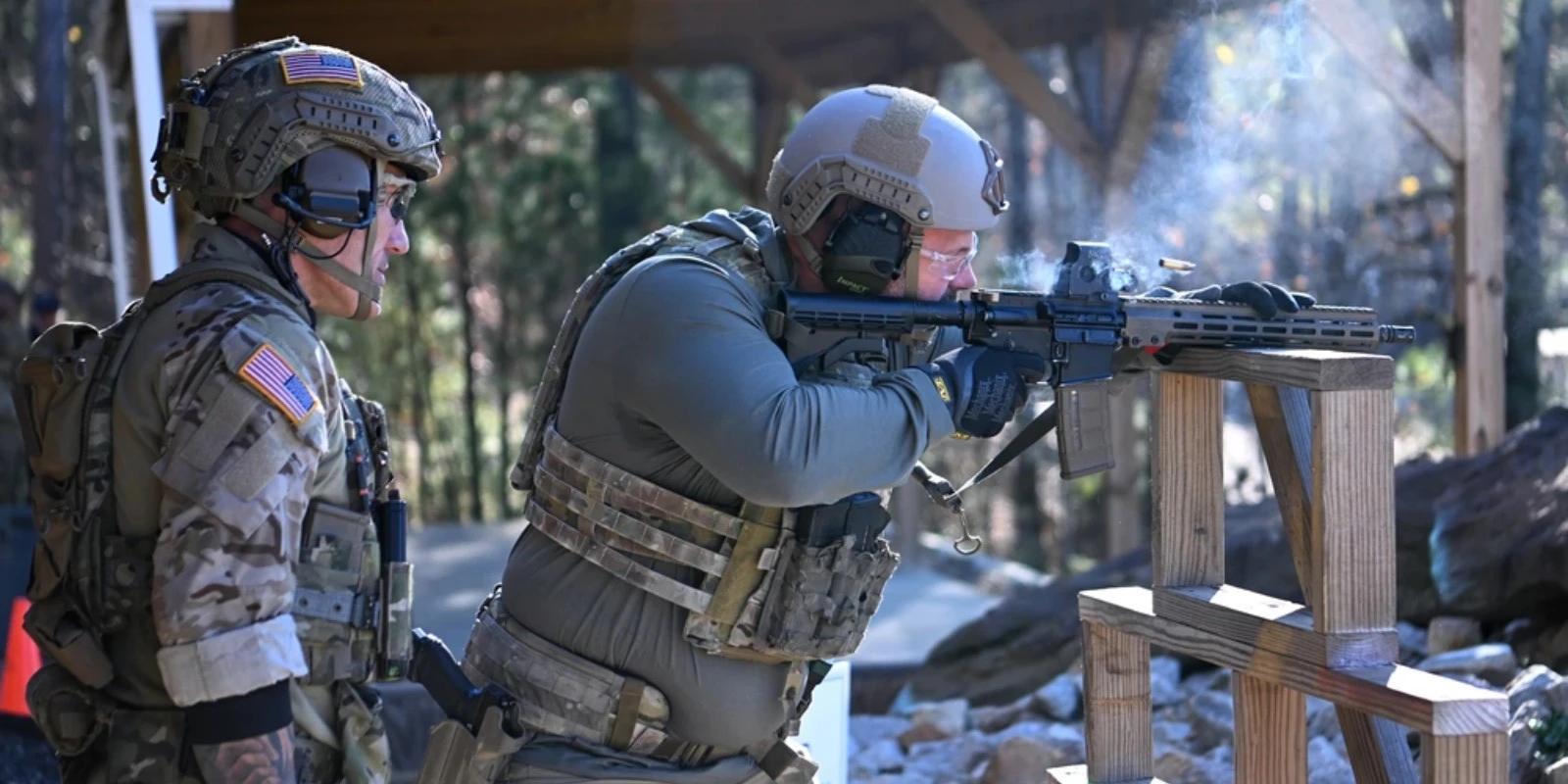HISTORY OF THE MILITARY IN ALASKA
By MyBaseGuide Staff Member

The military’s long and important history in the Great Land began at the very moment Alaska became American soil, Oct. 18, 1867.
Elements of the Army’s 9th Infantry were on hand as the Russian Golden Eagle was lowered and the Stars and Stripes were raised in Sitka, which became headquarters for U.S. Military District, Alaska.
The military has had a presence, even if very small at times, ever since.
Charged with maintaining law and order in the new territory, Soldiers helped quell uprisings and built new forts at Wrangell, Tongass Island, St. Paul Island, Kodiak Island and on the Kenai Peninsula. They also enforced regulations regarding the killing of fur seals, whose population had been severely depleted during the Russian reign.
The Army relinquished control of Alaska to the Treasury Department in 1877. The Treasury Department was joined by the Navy a year later, each sharing responsibility for governing the territory. The Army did not leave the territory entirely; the Signal Corps continued to operate weather stations, and a number of Army officers led small geographic explorations to learn more about the territory. These expeditions into various parts of Alaska continued through the turn of the century, as mapmaking and road- and bridge-building expanded the frontier.
The Klondike Gold Rush in Yukon Territory, Canada, plus later gold rushes in Alaska, helped the expansion, as thousands of people poured into the territory. In 1897, the United States government dispatched Capt. Patrick H. Ray and Lt. Wilds P. Richardson to investigate rumors of lawlessness and starvation among miners along the upper Yukon River. At Fort Yukon, they found that the single law enforcement agent, a U.S. commissioner, had not been able to contain the criminal elements among the large number of gold seekers who had flocked to the area. Ray recommended the establishment of a fort at St. Michael and the construction of a government steamer to patrol the Yukon River up to Fort Yukon. Reacting to Ray’s report, the Army Department dispatched a detachment of 30 officers and men to St. Michael, marking the return of the Army to the governing of Alaska.
Through the Lend-Lease Program, during World War II the United States transferred nearly 8,000 aircraft to the Soviet Union at Ladd Field, which later became Fort Wainwright. The aircraft were flown from Great Falls, Montana, to Ladd Field by American crews. Then Russian crews flew the planes on west to Siberia and on to the Russian front.
The pilots leaving Great Falls followed a series of small airfields that became known as the Northwest Staging Route. The airfields were located at intervals along a route that would later serve as the aerial footprint for the construction of the Alaska Highway.
One of those airfields, Big Delta Airfield, later became Fort Greely, providing ample acreage for Northern Warfare Training Center exercises and testing by the Cold Regions Test Center. Following the Japanese attack on Pearl Harbor, Army engineers began building airstrips in the Aleutian Islands to fight possible Japanese invasions there. The Army Corps of Engineers joined Canadian Forces in building the Alaska Highway in less than eight months. The 1,420-mile road was built as an overland supply route to get troops and supplies to Alaska. Officials in Washington, D.C., saw Alaska as a possible starting point for Japanese forces to invade the United States and Canada and took measures to prevent this.
In fact, Alaska was the only American soil other than Hawaii and the other American Pacific island territories to see fighting during World War II, when Japanese forces bombed Dutch Harbor and seized Attu and Kiska islands in the Aleutian Chain.
The successful battle to retake Attu, in June 1943, was one of the bloodiest in the war. The Japanese pulled out of Kiska before the Americans stormed ashore a few months later.
At the end of the war, many of the small Army posts throughout the state closed permanently. Postwar emphasis turned to training.
Following the National Security Act of 1947, the Army planned to move its operations to a new site, also named Fort Richardson, adjacent to the WWII installation. The Air Force assumed control of the original Fort Richardson and renamed it Elmendorf Air Force Base, gaining full ownership of Elmendorf and its facilities in 1951. The Alaskan Command, established Jan. 1, 1947, and headquartered at Elmendorf, was a unified command under the Joint Chiefs of Staff, based on lessons learned during WWII when a lack of coordinated effort hampered operations to drive the Japanese from the western Aleutian islands of Attu and Kiska. Elmendorf officially became an Air Force base on March 26, 1948. The new name for the headquarters for all Army personnel in Alaska became U.S. Army, Alaska, or USARAL, joining Alaskan Air Command as a component of Alaskan Command.
Military missions assigned to USARAL included ground and air defense of Alaska, with priority to the Anchorage and Fairbanks areas; developing cold-weather and mountain-warfare doctrines; conducting a cold-weather and mountain school at Fort Greely; providing logistical support to Air Force and Navy elements in Alaska; conducting National Guard and U.S. Army Reserve training; supervising Reserve Officer Training Corps activities; and providing for internal security, including plans for recovery from nuclear attack.
The uncertain world situation in the late 1940s and early 1950s caused a major buildup of air defense forces in Alaska. The propeller-driven P-51s were replaced with F-80 jets, which in turn were replaced in succession by F-94, F-89 and F-102 interceptor aircraft for the defense of North America. The Air Force built an extensive aircraft control and warning radar system with sites throughout Alaska’s interior and coastal regions. Additionally, the Air Force, out of necessity, built the White Alice Communications System (with numerous support facilities around the state) to provide reliable communications to these far-flung, isolated and often rugged locales. The Alaskan NORAD Regional Control Center at Elmendorf was installed in 1961, serving as the nerve center for all air defense operations in Alaska.
Air defense forces reached their zenith in 1957 with almost 200 fighter aircraft assigned to six fighter interceptor squadrons located at Elmendorf and Ladd Air Force Base. Eighteen radar sites provided aircraft control and warning. Elmendorf’s motto became “Top Cover for America,” which AAC adopted in 1969. With the end of the Cold War and the increased emphasis on Alaska’s strategic importance, the motto changed to “Top Cover and Global Power” and then to “Top Cover and Global Engagement.”
The late 1950s, ’60s and early ’70s brought about a gradual but significant decline in air defense forces in Alaska because of mission changes and the demands of the Vietnam War. The Air Force inactivated five fighter squadrons and closed five radar sites.
In 1961, the Department of Defense consigned Ladd Air Force Base to the Army, which renamed it Fort Wainwright. Elmendorf also began providing more support to other Air Force commands, particularly Military Airlift Command (now Air Mobility Command) C-5 and C-141 flights to and from the Far East.
By 1959, several Army Nike Hercules missile battalions were activated in the Anchorage and Fairbanks areas. The last Nike Hercules battalion, which included the battery at Site Summit overlooking Anchorage, was deactivated in 1979.
July 1953 saw USARAL’s combat units officially reorganized into the 172nd Infantry Brigade (Mechanized) at Fort Richardson and the 171st Infantry Brigade (Mechanized) at Fort Wainwright. The two brigades were redesignated as light-infantry brigades in 1969.
USARAL was discontinued as a major subordinate command Dec. 31, 1974, and the 172nd Infantry Brigade (Alaska), headquartered at Fort Richardson, assumed command and control, reporting to Forces Command at Fort McPherson, Georgia.
In the era of cutbacks that followed American disengagement in Vietnam, ALCOM was disestablished in 1975 and replaced with Joint Task Force Alaska and Joint Task Force Aleutian. Despite a diminished number of personnel and aircraft, the arrival of the 43rd Tactical Fighter Squadron in June 1970 from MacDill Air Force Base, Florida, signaled a new and flexible role for Elmendorf-based units. The squadron gave AAC an air-to-ground capability that was further enhanced with the activation of the 18th Tactical Fighter Squadron at Elmendorf, also with F-4Es, on Oct. 1, 1977.
The 171st Infantry Brigade was deactivated in fiscal year 1973. The 6th Infantry Division (Light), headquartered at Fort Richardson, was activated in 1986, replacing the 172nd Infantry Brigade. The strategic importance of Elmendorf Air Force Base was exercised during the spring of 1980 when the 18th Tactical Fighter Squadron deployed eight of its F-4Es to South Korea to participate in exercise Team Spirit. It was a historic first and underlined an increasing emphasis Alaskan Air Command placed on its tactical mobility.
The strategic location of Elmendorf on the Great Circle Arctic Navigation Routes made it an excellent deployment center, a fact that validated the contention of Billy Mitchell, who in 1935 declared Alaska to be “the most strategic place in the world.” Deployments from Elmendorf to the Far East are now conducted on a routine basis. The 1980s witnessed a period of growth and modernization of Elmendorf. During 1982, the 21st Tactical Fighter Wing converted from F-4s to F-15s. The 18th Tactical Fighter Squadron was assigned to Eielson Air Force Base, where it was equipped with A-10s.
The 54th Tactical Fighter Squadron, of Aleutian Campaign fame, activated once again in 1987. Rounding out the modernization program was the construction of an enhanced Regional Operations Control Center, completed in 1983, and the replacement of the 1950s-generation aircraft control and warning radars with state-of-the-art AN/FPS-117 Minimally Attended Radars. The integrated air warning and defense system became fully operational in mid-1985. Alaska’s air defense force was further enhanced with the assignment of two E-3 Sentry “AWACS” to Elmendorf in 1986.
The Alaskan Command was re-established at Elmendorf in 1989 as a subunified joint service command under the U.S. Pacific Command in recognition of Alaska’s military importance in the Pacific region. Concurrently, Joint Task Force Alaska and Joint Task Force Aleutian were disestablished. In October 2014, Alaskan Command was reassigned from U.S. Pacific Command to U.S. Northern Command; Alaskan Command is responsible for the planning and execution of the U.S. Northern Command mission in Alaska. Its importance was further recognized when the 90th Fighter Squadron moved to Elmendorf from Clark Air Base in the Philippines in May 1991 and was equipped with the F-15 Strike Eagle. The Pacific Regional Medical Center moved from Clark AB to Elmendorf and construction of a new hospital began in 1996. The early 1990s also saw major organizational changes and an expansion of Elmendorf’s importance. In 1991, the 21st Tactical Fighter Wing was reorganized as an objective wing, and all the major tenant units on Elmendorf were placed under it.
The 21st Wing inactivated Dec. 19, 1991, when the 3rd Wing was reassigned from Clark Air Base to Elmendorf Air Force Base. The 3rd Wing constitutes one of the longest-serving and most distinguished wings in the Air Force — its progenitor having been first activated July 1, 1919.
The 6th ID (L) was actively involved in training exercises in Japan and Thailand, at the Joint Readiness Training Center in Arkansas and Louisiana, and throughout Alaska until its deactivation in July 1994.
Once again the U.S. Army Alaska, this time familiarly known as USARAK, became an active headquarters at Fort Richardson. In 2005, USARAK began to build up the 4th Brigade Combat Team (Airborne), 25th Infantry Division.
In 2005, Congress announced the latest round of Base Closure and Realignment activities. Elmendorf Air Force Base and Fort Richardson were chosen to realign under a single support agency as a single installation known as Joint Base Elmendorf-Richardson. The Air Force activated the 673rd Air Base Wing to take over the base support and garrison functions of the two bases, and all personnel assigned to those functions transferred into the new unit June 24, 2010, initially still under the direction of the 3rd Wing.
Complete turnover of responsibility for base support and garrison functions at Joint Base Elmendorf-Richardson occurred with the arrival of the 673d Air Base Wing command element July 30, 2010. Today, the joint base enjoys a unique partnership among three Air Force total-force wings, one Army Brigade and 55 tenant units that include an Air Force Reserve unit, USARAK and its components, a Numbered Air Force and its components as well as the Alaska National Guard and Air National Guard. Military forces from all services, including the Marines, Navy and Coast Guard, are present and active on the installation.
Wilds P. Richardson
As more and more people came into Alaska and northwestern Canada, the necessity for better communications with the Lower 48 states became critical. The Washington-Alaska Military Cable and Telegraph System connected all the forts in the territory with Seattle. By 1903, the line stretched from Seattle to southeastern Alaska, Valdez, the Interior and Nome. The project fell under the direction of Brig. Gen. Adolphus W. Greely. Lt. William “Billy” Mitchell, another officer who would later achieve military fame, also worked on the four-year project. While Greely and his men struggled to complete the WAMCATS project, Richardson, on his third tour of duty in Alaska, headed the Alaska Road Commission, building garrisons and trails throughout the enormous territory. The Army in Alaska saw a decline in activity from 1908 to 1940, with a brief surge during World War I. Work continued on building roads and bridges and improving trails during this period. As the world prepared for another great war in 1940, military construction in Alaska accelerated. In 1940, Ladd Field, named after an Army aviator killed in an airplane crash in 1935, was built near Fairbanks as a cold-weather test station, while Fort Richardson, named for Wilds P. Richardson, was built in 1940-1941 near Anchorage. Col. Simon Bolivar Buckner assumed command of the Alaska Defense Force in 1940 and while at Fort Richardson achieved the ranks of brigadier and major general. Construction of the airfield at Fort Richardson began June 8, 1940. The Army intended it to be a major and permanent military installation. The first Army Air Corps personnel arrived Aug. 12, 1940, led by Maj. Everett S. Davis. On Nov. 12, 1940, the War Department formally designated the installation Fort Richardson. The air facilities and flying field on the post were named Elmendorf Field in honor of Capt. Hugh M. Elmendorf, who was killed in 1933 while flight testing an experimental fighter, the Consolidated Y1P-25, near Wright Field, Ohio. Though he apparently had no ties to Alaska, Elmendorf was a contemporary and friend of many of the leading Army Air Forces commanders before the war and would have doubtless figured prominently in the command hierarchy.Hugh M. Elmendorf
The first Air Force unit to be assigned to Alaska, the 18th Pursuit Squadron, arrived in February 1941. The 23rd Air Base Group was assigned shortly afterward to provide base support. Other Air Force units poured into Alaska as the Japanese threat developed into World War II. The Eleventh Air Force activated at Elmendorf Field on Jan. 15, 1942. The field played a vital role as the main air logistics center and staging area during the Aleutian Campaign and later air operations against the Kuril Islands of Japan. Following WWII, Elmendorf Field assumed an increasing role in the defense of North America as the uncertain wartime relations between the United States and the Soviet Union deteriorated into the Cold War. The Eleventh Air Force was redesignated as the Alaskan Air Command on Dec. 18, 1945.SHARE:
TAGS:
JOIN OUR NEWSLETTER
Get the latest news and military discounts















